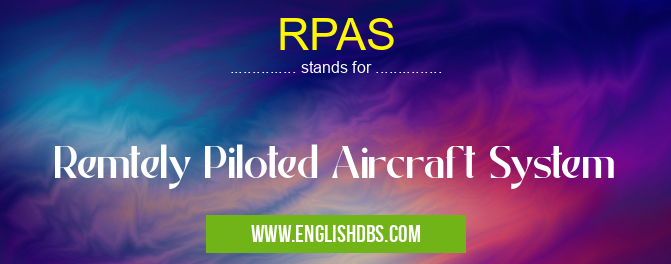What does RPAS mean in AIRCRAFT & AVIATION
Remotely Piloted Aircraft System, commonly referred to as RPAS, is an automated aircraft system, which can be operated remotely by a pilot on the ground. This technology has revolutionized the aviation industry and made it possible to operate unmanned aerial vehicles (UAVs) for both commercial and military purposes. RPAS have been used extensively over the past few years in search and rescue operations, border surveillance, agricultural monitoring and emergency response missions etc.

RPAS meaning in Aircraft & Aviation in Miscellaneous
RPAS mostly used in an acronym Aircraft & Aviation in Category Miscellaneous that means Remtely Piloted Aircraft System
Shorthand: RPAS,
Full Form: Remtely Piloted Aircraft System
For more information of "Remtely Piloted Aircraft System", see the section below.
Advantages of using RPAS
The main advantage of using RPAS is its ability to perform complex tasks without requiring large amounts of manpower and resources that would otherwise be needed if manned flights were conducted for the same purpose. Also, since these systems are highly automated they provide a high degree of safety compared to manual operations. Furthermore, these systems can be deployed rapidly in any environment without having to go through extensive procedures such as scheduling takeoff slots or obtaining permission from air traffic controllers etc., making them ideal for emergency response missions or other quick action scenarios. Finally, since UAVs are able to stay airborne longer than traditional planes they can cover wider areas more quickly and economically than other options available today.
Essential Questions and Answers on Remtely Piloted Aircraft System in "MISCELLANEOUS»AIRCRAFT"
What is a Remotely Piloted Aircraft System (RPAS)?
RPAS, or Remotely Piloted Aircraft System, is an unmanned aerial vehicle (UAV) system that is directed from a ground control station. These systems are used in situations where it's deemed too dangerous, expensive or otherwise impractical to use manned aircraft.
What kind of missions do RPAS fly?
RPAS can be used for many kinds of missions, including surveillance and reconnaissance, monitoring of hazardous material spills, law enforcement, disaster relief efforts, search-and-rescue operations, border patrol activities and more.
Who uses RPAS and what are the benefits?
RPAS are primarily used by commercial companies and government agencies in order to monitor environmental conditions and take advantage of cost savings. The primary benefit of using RPAS is that it can provide a much quicker response than traditional aerial methods. Additionally, they offer more precise control over operations at lower costs than traditional pilots and aircraft.
How safe are Remotely Piloted Aircraft Systems?
Safety is always the priority when operating an RPAS platform; they are designed and manufactured with stringent safety protocols to ensure their operation is as safe as possible. Operators receive extensive training before operating an RPAS and must follow all applicable regulations whenever they fly.
Are there any airspace restrictions for operating an RPAS?
Yes. Depending on your location, there may be airspace restrictions in place which dictate where you can fly and how high you can fly your RPAS platform. Additionally, some areas may require special permission before flying a drone in that airspace. It's always best to consult local aviation authorities before flying any type of aircraft.
How much does it cost to operate an RPAS?
The cost of operating an RPAS varies depending on the size of the system as well as the mission being flown; typical costs will include fuel for the drone plus time spent preparing for operations and completing post-flight analyses after operations have finished. In addition, additional maintenance or licensing fees may apply depending on where you plan to fly your system.
How long can Remotely Piloted Aircraft Systems stay airborne?
This depends on several factors such as altitude requirements for flight operations as well as battery capacity; usually these systems can stay aloft for up to two hours without issue but this will also depend on mission duration requirements and weather conditions during flight operations as well as other unseen factors such as wind speed & direction..
Do I need special equipment or devices to control my Remotely Piloted Aircraft System?
Yes; most operators will use either hand-held remote controllers or dedicated software packages to control their UAVs while in flight according to their needs at the time​.
Final Words:
In short, Remotely Piloted Aircraft Systems have revolutionized the world of aviation by making it possible to deploy unmanned aerial vehicles safely and efficiently in a variety of applications ranging from military use to search & rescue operations. With their ability to provide quick response times at much lower costs than traditional methods they have become increasingly popular in recent years with many companies now offering services related to RPAS technology.
